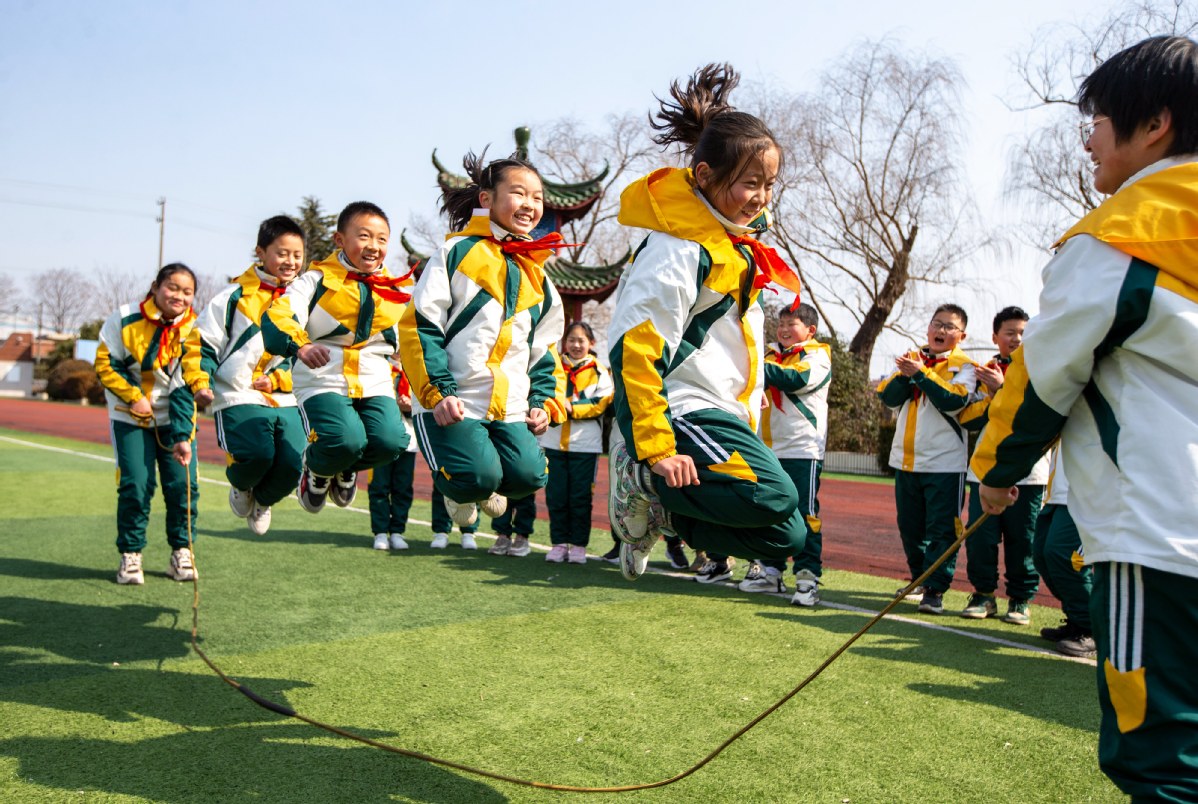China can cope with demographic 'new normal'
By Yuan Xin | chinadaily.com.cn | Updated: 2024-01-17 16:01

On Wednesday, the National Bureau of Statistics released data showing that the total population at the end of 2023 in the Chinese mainland was more than 1.409 billion, a decrease of 2.08 million from the previous year. The total number of births for the year was 9.02 million, and the total number of deaths was 11.1 million.
In the long run, negative growth and aging will be two characteristics of China's demography. In fact, China is undergoing a demographic transition, with its population peaking at 1.41 billion in 2021-22. The total fertility rate, a key indicator of societal dynamics, nosedived to 1.1 in 2022, signaling a seismic shift in China's population. This unfolding narrative will not only shape China's future but also have a profound impact on the global demographic tapestry.
Technology, retirement reforms are key to aging challenges
Looking ahead to the next three decades, China's demographic future hinges on the trajectory of the fertility rate: a gradual recovery to 1.8 promises a stable population of about 1.4 billion; a conservative increase to 1.4-1.5 hints at a population of about 1.3 billion; and a decline to 0.8-0.9 would mean China's population dropping to 1.2 billion by 2050.
These scenarios, however, suggest China will remain one of the two most populous countries in the world, with a projected range of 1.2-1.4 billion people by mid-21st century.
The peak population of over 1.41 billion in 2021-22 indicates China has reached a significant juncture in demographics. Aligned with China's "two-stage, two-step" approach to modernization, the population peak coincides with the efforts to realize socialist modernization by 2035. China's colossal population, accounting for 14-18 percent of the global total, is poised to embark on a transformative journey toward modernity.
The year 2022 ushered in a period of negative population growth. As a result of the three-year COVID-19 pandemic, diminishing fertility rate and deferred marriages, this trend signals a fundamental shift in social values. Addressing this requires recalibration of social and economic policies.
By the end of 2023, the population aged 60 and above is 296.97 million, accounting for 21.1 percent of the total population, among which the population aged 65 and above is 216.76 million, accounting for 15.4 percent of the total population. Projections indicate that by the middle of this century, there will be a peak of 520 million elderly people, leading to an aging population that is likely to approach 50 percent. That poses a great challenge to existing social and economic structures, and demands innovative solutions.
First, the working-age population continues to decrease. The population aged 15 to 59 is projected to decrease from the current 864 million to 650 million by the middle of this century. But shrinking labor force may not necessarily lead to a shortage. On the one hand, the modernization and digitalization of society are deepening, with technology, artificial intelligence, robots, and large-scale equipment increasingly substituting for labor. On the other hand, the annual number of graduates from institutions of higher education exceeds 10 million, and the number of graduates from secondary vocational and technical schools surpasses 5 million, leading to intense competition for employment and long-term pressure on the realization of a full employment strategy.
Second, there is a vast population of younger elderly individuals. Over the next 30 years, population aging will exhibit a typical pattern of aging at a younger age. Those aged 60 to 69, considered as younger elderly, will account for approximately 40-50 percent of the total elderly population, increasing from 150 million to 210 million. This presents a window of opportunity for implementing retirement system reforms and promoting the social participation of the elderly.
Third, there is a shift from a society primarily focused on raising children to one primarily focused on elderly care. Since 2021, the elderly dependency ratio has exceeded the child dependency ratio. Experiences from developed countries indicate that the social investment per capita for elderly care is several times that for childcare. With the increasing elderly population, longer lifespans, and improved pension standards, the social pressure for elderly care is growing.
Just as the General Office of the State Council's recent document promoting the silver economy indicated, silver economy can also bring golden opportunities. The silver economy refers to the sum of economic activities that provide products or services to the elderly, as well as preparations for the aging stage, involving a wide range, a long industrial chain, diverse formats, and enormous potential.
Urban-rural disparity in eldercare should be narrowed
After the launch of reform and opening-up, internal labor migration unleashed a formidable force driving China's economic ascension. In 2023, the urban population was 932.67 million, an increase of 11.96 million over the end of the previous year. The rural population was 477 million, a decrease of 14.04 million. The proportion of urban population to the total population (urbanization rate) was 66.16 percent, an increase of 0.94 percentage points over the previous year.
The floating population and migrant workers comprise individuals moving from rural areas to urban centers, with young and middle-aged individuals making up the majority. The migration of young and middle-aged people from villages to cities means an inadvertent increase in the aging population in rural areas, and a relative decrease in the aging population in urban areas, creating an inverted demographic pattern wherein rural areas face early, rapid aging, and have a relatively large elderly population. So to address the population aging problem, the authorities have to first address the problems in rural areas.
Intensifying population divergence: According to its urbanization road map, China wants to achieve an urbanization rate of 70 percent by 2030 and 75-80 percent by 2050, with the urban population crossing 1 billion and rural population falling below 300 million.
In the long run, with the fertility rates falling in all regions, human migration may no longer be an effective means to regulate regional population distribution.
Against the backdrop of low birth rates and longer lifespans, the loss of demographic dividends has created a series of challenges. The population aging trend will continue throughout the 21st century, intertwining with challenges created by slower economic development. These challenges will raise social concerns, encompassing, among others, economic, social, health, regional distribution, and gender-related factors.
Addressing these challenges requires a paradigm shift, fostering a proactive attitude toward aging society, and adopting a threefold approach — scientific understanding, proactive adaptation, and positive response. Scientific understanding entails analyzing population decline and aging from the perspective of demographic principles without exaggerating the negative impacts of population aging and acknowledging its positive impacts.
To overcome the impacts of rapidly rising numbers of elderly people and a shrinking population, adapting to the changing situation is crucial. There is also a need to recognize and explore new opportunities, and adopt a pragmatic approach to overcome the difficulties.
To deal with the challenges created by an aging society, in order to promote sustainable development, we need robust and comprehensive reforms. First, it is necessary to not view the aging society through the lens of declining demographic dividends. Second, it is also necessary to extend the scope of the policies beyond the elderly population to achieve high-quality development. And third, it is important to move beyond the accepted policies to address this modern development problem.
Encourage couples to have at least one kid
To encourage young couples to have two, if not three, children, support policies should not be focused on couples who have two-three children; instead, they should also be targeted at couples who have just one child. In short, implementing a fair and equitable policy for all types of childbirth is reasonable.
The central and local governments' support policies for couples who have two-three children are complex. The policy disparities are substantial, even though they provide economic incentives, extended maternity leave and caregiver leave. Moreover, the authorities should explore the possibility of including assisted reproductive technologies in the healthcare policy. Beyond financial support, creating a supportive environment for families with multiple children requires public and government support.
The use of funds alone, even up to 3 percent of GDP, may not necessarily increase the fertility rate. Cultural shifts, especially among the younger generation, emphasize individual development. To increase the fertility rate, comprehensive and long-term efforts, marked by unwavering determination and patience, are required.
The social pattern of negative population growth and a rising aging population is likely to persist. Accepting the fundamental shifts in perspective, developing scientific understanding, adapting to the changing times, and responding positively are the logical steps toward overcoming these challenges. Only by adopting a creative approach to navigating the socio-demographic complexities can we achieve steady, sustainable high-quality development. And China is capable to do so.
The author is deputy chief of the China Population Association and a professor of demography at Nankai University.
The views don't necessarily reflect those of China Daily.
If you have a specific expertise, or would like to share your thought about our stories, then send us your writings at opinion@chinadaily.com.cn, and comment@chinadaily.com.cn.
























